
The learning curve has been steep and the development cost high. Yet, the Tejas project has turned out to be a valuable investment
for HAL and the nation. The project, conceived in 1983, is finally ready to serve the Indian Air Force well into the future, reducing the
dependence of India’s air warriors on foreignmade fighters
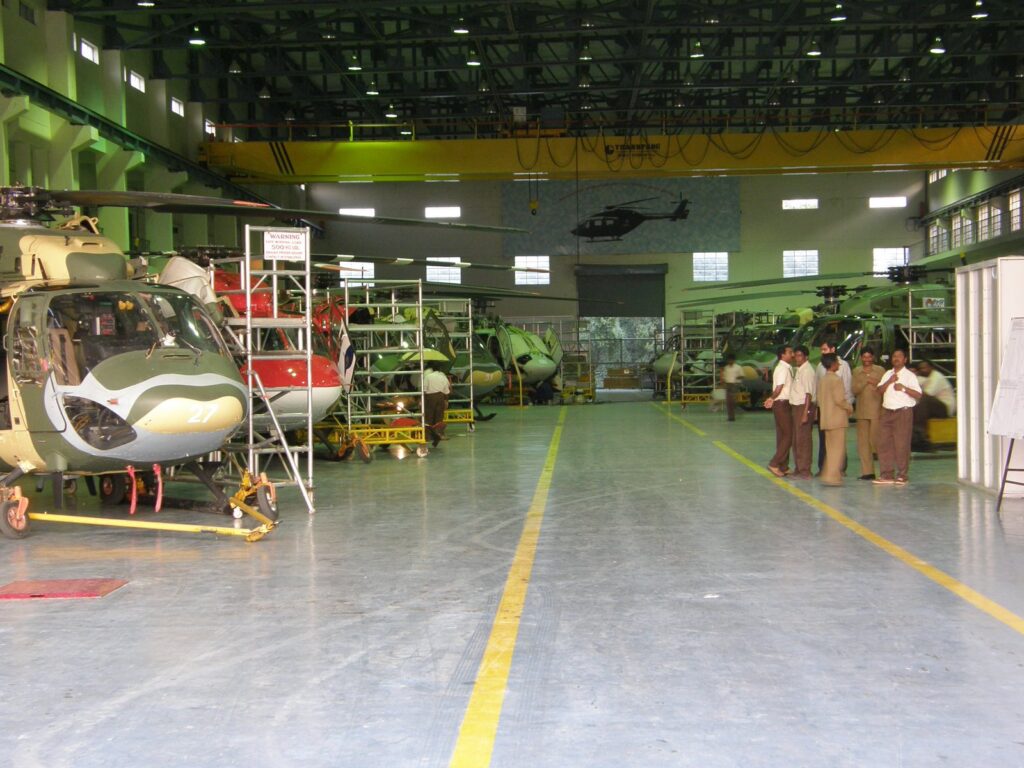
The HAL Dhruv production line is operating at full capacity
Hindustan Aeronautics Limited (HAL), a public sector undertaking (PSU) under the Ministry of Defence, is literally flying high. In the first quarter of
the current fiscal year (April-June), HAL recorded a 77% increase in gross profit on a year-on-year basis of rs 1,437 crore, translating into net profit of rs 814 crore. Over the past year, investors have harvested returns up to 140% by trading in the company’s stocks. This year, the value of its stocks has appreciated by 64%. The defence sector PSU, which has more than 25,000 employees on its payrolls, posted a net income of
rs 7,621 crore in Financial Year (FY) 2023- 24. In the first quarter of FY 2024-25, HAL reported consolidated operating revenue of rs4,348 crore, which is an 11% increase compared to the same quarter the previous
year, when the company generated rs 3,915 crore as revenue. It’s obvious that the robust financial health of HAL has not been achieved in a day. It’s the result of 84 years of hard work technological innovations, and research and development (R&D) towards making the Indian Air Force self-reliant. The journey from developing the HF24 (Marut or Wind Spirit) through the 1960s, which entered active service in November 1969 with the 10 Squadron (Daggers), to building the 4.5-generation Tejas Mark 1A charts the long and glorious arc of
HAL’s evolution. “This is the result of right thinking, hard work, dedication and trust
of the company’s management and employees by its consumers. This achievement has increased our responsibility,” says Gopal Sutar, HAL spokesperson. Currently, HAL’s pipeline is brimming
with multiple projects that are in various stages of progress, ranging from design to the manufacture of fighter, transport, and
trainer aircraft, helicopters, developing jet engines and marine gas turbine engines,
avionics, upgrading the existing fleet of the IAF and ensuring the supply of spare parts. But its biggest challenge at the moment is
the time-bound delivery of the Tejas Mark 1A to the IAF. In April this year, the PSU received a fresh order from the Ministry of Defence
for the purchase of 97 Tejas Mark 1A air
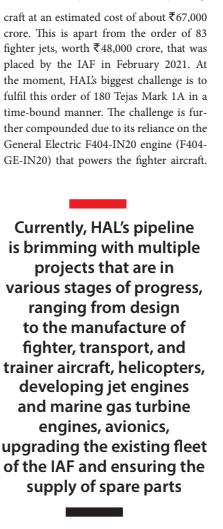
This crucial aspect of serial production of the Tejas Mark 1A is beyond HAL’s control. Any delay in the supply of these engines
will severely impact the delivery timelines with serious repercussions for the country’s security structure.
Once the indigenously developed fighter aircraft is inducted, the IAF will start retiring the remaining MiG series in a phased manner. Though HAL has assured the IAF of timely delivery from October-end, the
latter recently sought early delivery of the fighter aircraft. In March this year, the Tejas Mark 1A undertook an 18-minute maiden test flight at HAL’s Bengaluru facility. Since
then, it has been undergoing integration trials for various onboard equipment and
weapon systems. This 4.5-generation fighter can be refuelled mid-air and carries an array of modern equipment such as active electronically scanned array radar (AESA), beyond visual
range (BVR) missiles, and electronic warfare suite. The version that will be handed
over to the IAF can be flown at 1.6 Mach at a maximum altitude of 15,240 metres
and can be armed with six different types of missiles. Besides the current order of 180 aircraft of the Mark 1A variant, the IAF is
already operating 40 Tejas Mark 1 fighters, including the twin-seater, that make up the two squadrons in active service.

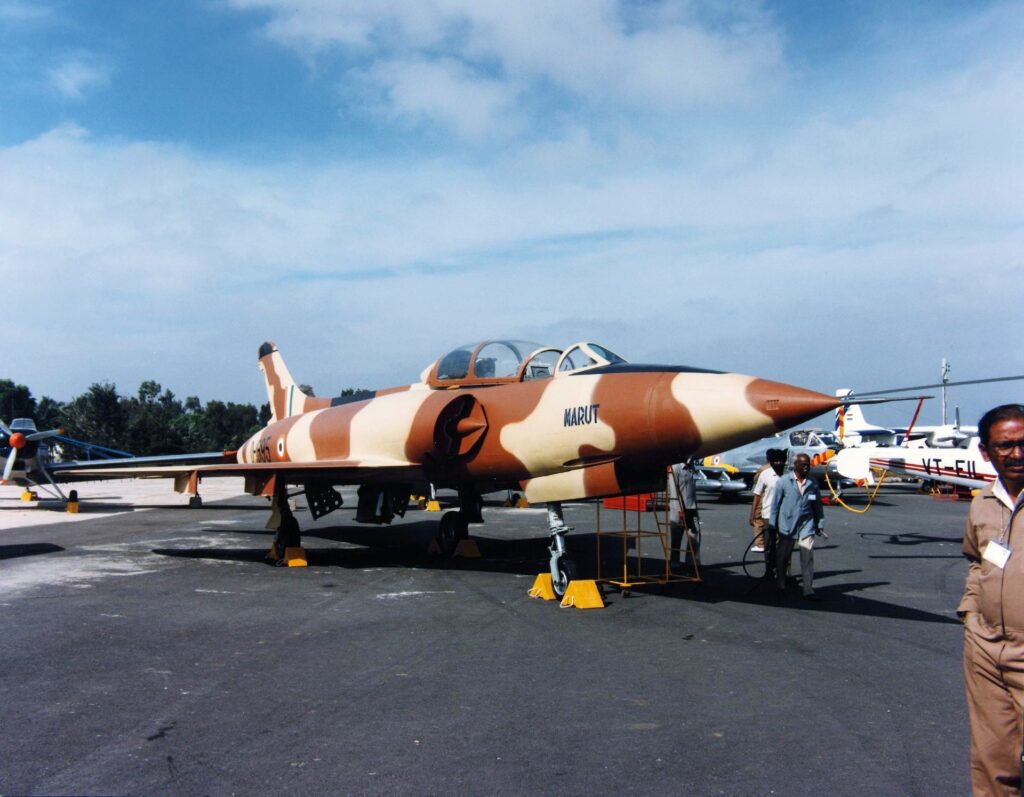
(Left) Workers checking spare fuel tanks at the HAL facility during World War II. HF-24 (Marut) was the first indigenously built fighter
Birth Of HAL
The story of HAL began on December 23, 1940, when a prominent businessman from Karnataka, Walchand Hirachand, with support from the then government of Mysore, set it up. In March 1941, the British government in India became a shareholder, before taking over the management in 1942. Through the World War II period, HAL
primarily serviced the maintenance and repair needs of the Royal Air Force and the US Air Force, operating in the Eastern front against the advancing Japanese military. After India became independent in 1947, HAL was brought under the administrative control of the Ministry of Defence in January 1951. In a parallel development,
the Government of India established the Aeronautics India Limited (AIL) in August 1963 for the manufacture of the MiG-21
under a licensing agreement with the Soviet Union. A year later, in October 1964,
AIL was merged into HAL. Since then, the PSU has been at the forefront of developing and manufacturing aircraft, helicopters, avionics and communication equipment
for India’s armed forces and civilian market. Besides serving the IAF, Indian Army, Indian Navy and Coast Guard, HAL has
established strong collaborative links with
organisations such as the Defence Research and Development Organisation (DRDO),Indian Space Research Organisation
(ISRO), the Mauritius Police Force, Boeing of the US and Airbus Industrie in France.
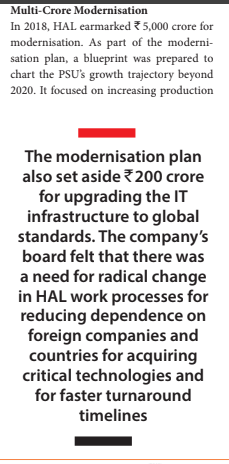
capacity and expanding its research and development capabilities for competing
with global military aviation giants on an equal footing. The modernisation plan also
set aside `200 crore for upgrading the IT infrastructure to global standards. The company’s board felt that there was a need for radical change in HAL work processes
for reducing dependence on foreign companies and countries for acquiring critical technologies and for faster turnaround
timelines from the concept stage to serial production of hardware. The IAF and other defence forces need
a range of helicopters and fighter aircraft. Though HAL has the capacity to develop
and serially produce light and medium lift helicopters, for attack and heavy rotary wing aircraft India is still dependent on imports. The shortage of fighter aircraft has been a cause of concern for the IAF. The practice of acquiring foreign-built fighters has also acted as an impediment for the development of indigenously built fighting platforms.
HAL embarked on developing an indigenous fighter platform a little more
than two decades ago as part of the Light Combat Aircraft (LCA) programme, which
resulted in the Tejas Mark 1 fighter. But by the time it was delivered, the IAF pointed out a host of shortcomings. This forced

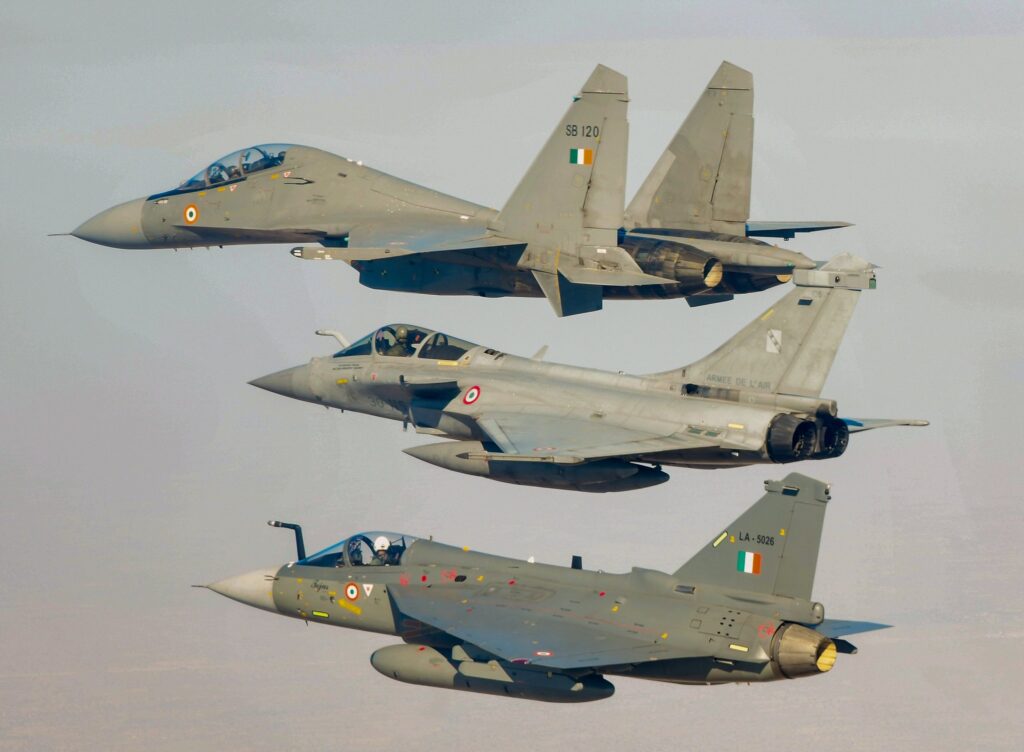
(Left) 45 Squadron is based at the Sulur airbase. The Sukhoi MK1, Rafale and Tejas Mark 1 operating together during Exercise Garuda
HAL to develop the 4.5-generation Mark 1A variant that met all the current and
some of the anticipated needs of the IAF. To a great extent, HAL’s ‘beyond 2020’
vision stemmed from its experience in developing the LCA platform. It underlined
the need for a more robust R&D programme and recruitment of better qualified and skilled engineers. To address the
future challenges around human capital, HAL established seats in the Indian Institutes of Technology (IITs) in Kanpur, Roorkee, Kharagpur and Mumbai. It also brought various R&D centres spread across
the country under the Committee of Institutional Network for better coordination and synchronisation of workflows. Former HAL Chairman Dr R.K. Tyagi told me that during his tenure, HAL signed a memorandum of understanding (MoU) with Transparency International for developing
a transparent work culture in the company. He also said that 10% of the annual profit
was earmarked exclusively for R&D in a separate fund.
The Tejas Chapter
When India laid the foundation of the indigenous LCA programme in 1983, not many took it seriously. At that time, the
government had asked defence scientists to outline the project for which rs 560 crore was sanctioned. It took another 10 years to complete the technology development
phase and build an experimental aircraft. In 1993, the government sanctioned rs 2,188
The DRDO, headed by Dr A.P.J. Abdul Kalam, stepped in to keep the
LCA programme alive by developing key indigenous technologies. Under his
guidance, the DRDO developed the light
composite material that brought down the weight of the aircraft significantly.
It also developed the glass cockpit and various sub-systems
crore after green-flagging the full-scale engineering development programme. In
January 2001, the first prototype of the LCA took to the skies in a test flight for the first time. On May 4, 2003, Prime Minister
Atal Bihari Vajpayee christened the LCA Tejas.
From 1995 to 2001, the LCA programme faced several hurdles. But the real hit came in 1998, when India conducted its second nuclear test at Pokhran on May 11 and May 13, which resulted in the US imposing severe economic sanctions. This had a direct bearing on the LCA programme as two US companies that were
working on the engine and aeronautics packages were forced to shut shop virtually overnight. That is when the DRDO, headed by Dr A.P.J. Abdul Kalam, stepped in to keep the LCA programme alive by developing key indigenous technologies.
Under his guidance, the DRDO developed the light composite material that brought down the weight of the aircraft significantly. It also developed the glass cockpit and various sub-systems. The delta-winged
fighter is equipped with state-of-the-art,
fly-by-wire flight control systems, integrated digital avionics and multimode radar that is housed in its nosecone. The fighter
is also equipped with high-speed cameras for surveillance and monitoring the flight paths of missiles and bombs towards the target. According to project officials, some of the features of Tejas are ahead of other fourth-generation aircraft in the world.
They also say that, with a more powerful engine that can push the aircraft to supersonic speeds and the addition of stealth features, the Tejas is capable of becoming a true-blue, fifth-generation fighter. One of the main reasons for the delay in the production of Tejas was the unavailability of a suitable engine after the Kaveri engine programme ran into technical problems. Ultimately, HAL settled for the F404-GE-IN20 engine for the LCA programme. In June 2023, HAL and General Electric signed an MoU for the supply of
an additional 99 F404-GE-IN20 engines
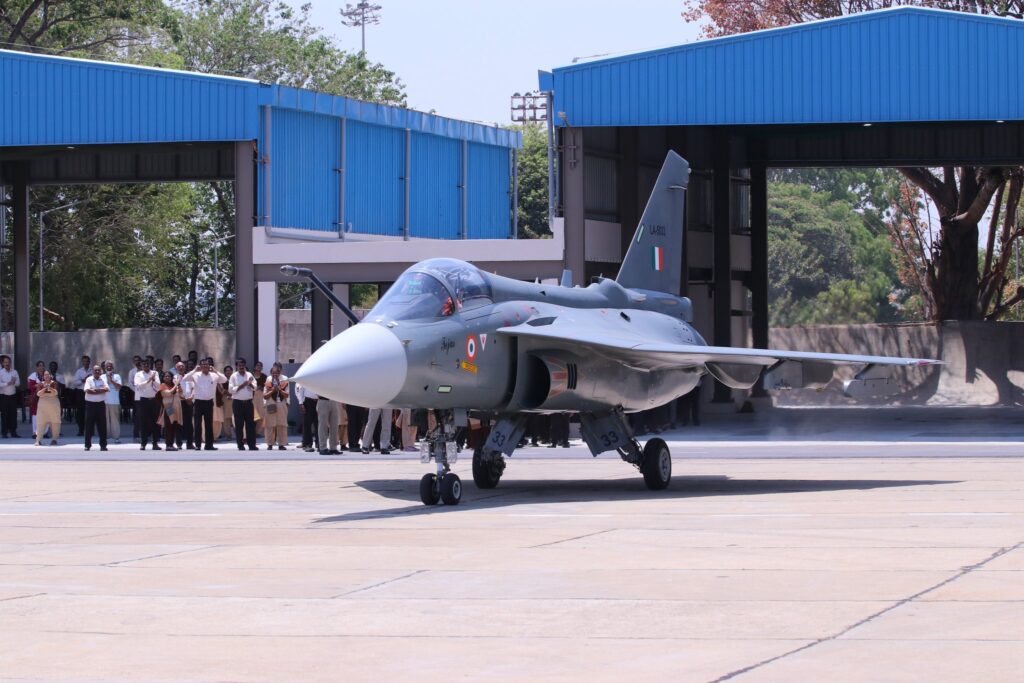
The 180 Tejas Mark 1A fighter ordered by the IAF will form the backbone of the air force
for the existing variants and joint manufacture of the F414-INS6 engine that will
power the Tejas Mark 2A that is scheduled to undergo its first test flight in 2025.
The F414-INS6 engine will also feature in the Advanced Medium Combat Aircraft
(AMCA) programme that is scheduled to be developed by 2028 by HAL. The naval
variant (LCA-Navy) also managed to pass its test flight by taking off from the skijump deck of the INS Vikramaditya. Since its first test flight, Tejas has logged more than 4,000 flying hours without any accidents, indicating its reliability.
Initial Operational Clearance
The flight for the crucial Initial Operational Clearance (IOC) took place on December 20, 2013, at the HAL facility in Bengaluru. The company and the IAF organised a
spectacular ceremony to mark the historic occasion, attended by the then Defence Minister, A.K. Antony, Air Chief Marshal
N.A.K. Browne, and HAL Chairman Dr R.K. Tyagi, among a host of other dignitaries. The function was also attended by
engineers and scientists of the IAF, DRDO, Bharat Electronics Limited, the Council of Scientific & Industrial Research, the Aeronautical Development Agency, and other organisations that contributed to the development of the LCA programme. I was part of a select group of journalists who attended the IOC ceremony. It was
a moving moment when Dr K. Tamilmani, DG (Aero), Centre for Military Airworthiness and Certification, presented the IOC certificate to Antony. In my despatch for the Rashtriya Sahara newspaper, I reported:
“On this occasion, Defence Minister Antony said, ‘It took 33 years to complete the Tejas project. The delay is a reality in front of the world. There is a lot to learn from the delay in the project, which will be a lesson for future projects.’ Until now (2013), the
Tejas project has cost rs 7,000 crore.” Speaking to me after the ceremony,
Dr Tyagi said Tejas had undergone rigorous test flights in varied conditions and seasons in Leh, Jamnagar, Jaisalmer, Uttarlai, Gwalior, Pathankot and Goa. He also said that various sub-systems such
as weapon delivery, multi mission radar, radar warning receiver, and hot weather missile firing tests were carried out during
the validation phase before the granting of the IOC.
Tejas Joins 45 And 18 Squadrons
In July 2016, the Tejas joined the IAF’s 45
Squadron, nicknamed ‘Flying Daggers’, that had flown HAL’s first indigenous aircraft, the HF-24. This squadron, with the motto of “Ajeetakshay”, operated out of the Naliya airbase in Gujarat before it was shifted to Chennai and then to Sulur, near Coimbatore.
On May 27, 2020, the fighter was in
ducted in 18 Squadron (Flying Bullets), also based at Sulur, after the Tejas Mark 1 was granted the Final Operational Clearance (FOC). To mark the occasion, the then Air Chief Marshal, R.K.S. Bhadauria,
not only received the certification document from R. Madhavan, Managing Director, HAL, but also flew the single-seater fighter. The former IAF chief was part
of the LCA development programme. As part of the induction ceremony, Bhadauria handed over command of 18 Squadron to
Group Captain Manish Tolani. Raised on April 15, 1965, 18 Squadron had been flying the MiG-27. It participated in the 1971 war against Pakistan and was the first IAF squadron to land at the Srinagar airbase. Flying Officer Nirmal Jit Singh Sekhon was posthumously awarded the Param Vir Chakra—the highest gallantry award—for exemplary bravery in
air defence of India’s northwestern border. For this reason, the squadron is also called ‘Defenders of the Kashmir Valley’. It was
number plated on April 15, 2016, before being redesignated on April 1, 2020. In November 2015, this squadron was presented with the Presidential Order for its exemplary record.
Price Of Tejas
In the past three and a half decades, the LCA development project and serial production of Tejas have cost more than `17,000 crore. It has been a worthwhile investment in developing an indigenous ecosystem for the production of future generation fighter aircraft. As far as the unit cost of
the Tejas is concerned, it’s one of the cheapest fighters in the world to offer such a wide range of capabilities. The per unit cost of the first batch of the Tejas Mark 1 that HAL handed over to the IAF was approximately
rs 160 crore. Any foreign-made fighter with comparable features and capabilities would have cost anything between rs 250 crore and rs 400 crore. The price of a Sukhoi is approximately rs 400 crore, while the unit price of a Rafale is reported to be rs 700 crore to rs 800 crore. HAL is making efforts to keep the cost of serial production of the Tejas
Mark 1 and Mark 1A low to make it competitive in the international market without compromising on quality


Add Comment